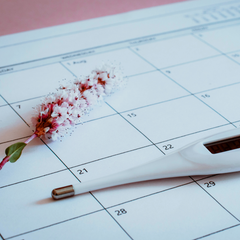First off, what does "charting your cycle" actually mean? Charting your cycle is a daily practice of observing and tracking your fertility biomarkers. It requires you to pay attention to fertility signs to identify where you are in your menstrual cycle.

Charting your menstrual cycle brings with it many insights and benefits depending on your goals and wishes. Throughout different times in your life, charting can be practiced for any intention of family planning, or for monitoring health.
Fertility tracking helps you track information about your own body that will serve you in all walks of life.
The menstrual cycle has been known as the fifth vital sign: it is an indicator of not only your reproductive health but also your overall wellbeing.
Chart for Family Planning
Fertility awareness based methods (FABMS) are an incredibly useful tool in family planning! When you chart, you learn to recognize when you’re fertile and when you’re not - and you can time your intercourse accordingly, whatever your intentions!
FABMs uses fertility markers to identify your fertile window, which is only 3-6 days each cycle. By working with a certified fertility awareness educator, following the rules of your chosen method, and using a smart basal body thermometer like Tempdrop to ensure that your temps are precise, you can achieve high effectiveness for FAMBs.
Fertility awareness also has the ability to improve communication between you and your partner. Unlike other methods of family planning, fertility awareness allows both individuals to play an active part in the effectiveness of the method.
Increase Chances of Conception
There is a common misconception ovulation always occurs on day 14, ever cycle, for every woman. This isn’t the case. Many women and couples who struggle to conceive can benefit from tracking their fertility, just by merely identifying when ovulation occurs.

By charting your cycle you can pinpoint ovulation more accurately and increase chances of conception by timing intercourse when ovulation actually happens for you. Studies show being able to correctly identify the window in which you ovulated can triple your likelihood to conceive.
Most FABMs determine ovulation by tracking cervical mucus (CM), a hydrogel secreted by your cervix that fluctuates with your hormone levels. Cervical mucus also keeps sperm alive and nourished long enough for conception to occur (learn more about charting CM here). For couples trying to conceive, understanding CM patterns is vital.
Cervical mucus tracking can be used in conjunction with other markers of ovulation, such as LH tests and basal body temperature tracking to get an even clearer picture of ovulation. By charting your cycle, you can know if and when ovulation occurred and, in many cases, uncover root causes of infertility to be able to treat and potentially conceive sooner.
Chart for Health
Menstrual cycle tracking can reveal underlying health issues and help you keep on top of possible fertility concerns. By tracking ovulation, you can get a snapshot of your overall reproductive health. Your hormones are responsible for more than just reproduction, they are involved in many other physiological processes as well. If something is awry with your hormones, this will be revealed in your menstrual cycle.

For example, thyroid dysregulation is often apparent in basal body temperature (BBT) charts (learn more here). Having data from charting can assist you in getting the correct diagnosis and treatments for diseases and illnesses.
You can also track the progress of any diet or lifestyle changes by tracking your cycle. Those with PCOS trying to treat the root cause of their PCOS often include dietary, exercise, and supplements or medications to their routine. Through charting, they can benefit from assessing and monitoring normal cycle parameters, which is basically a progress report for getting PCOS under control and figuring out what is or isn't working.
Alongside tracking your fertility signs, you can track things such as sleep, supplements, food, caffeine or alcohol, exercise, mood, and more. You can then make connections between your overall health and how these things tie in with the health of your cycle.
By assessing symptoms and normal cycle parameters, you can be aware of - and treat - any potential reproductive health challenges before they become more significant issues. Things like heavy and painful periods, anovulation, short luteal phases, and irregular cycles can all be clues of broader health concerns. By taking your menstrual cycle chart to your healthcare practitioner, you can reach a diagnosis sooner.

Why you should start charting your cycle now!
Charting your fertility signs takes only a few minutes each day and gives you a window into your overall health. Many women start charting their cycles for family planning purposes, and find that the benefits or fertility charting are many.

Nathalie Daudet is a social worker and FEMM instructor based in Winnipeg, Canada. She discovered fertility awareness after searching high and low for a non-hormonal method of birth control. After learning the magic of fertility awareness and the gift of body literacy, she decided to pursue formal fertility awareness training and share the knowledge of fertility awareness with women looking for a natural birth control option. Fertility Awareness Project is the hub for Nathalie’s FEMM classes in both group and individual formats, online and in person in Winnipeg. If you love this post and would like to thank Nathalie, shop Tempdrop with Nathalie's unique referral link.
